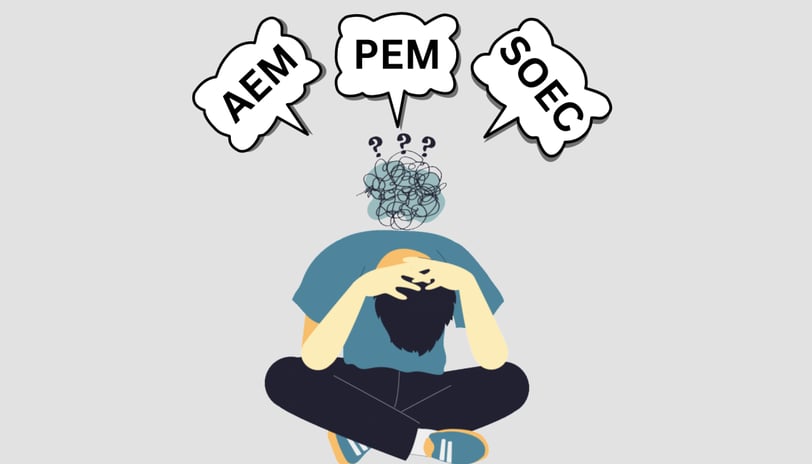SOEC vs AEM vs PEM Electrolyzers
This blog discusses the difference between three of the most popular types of Electrolyzers
ELECTROLYZER


SOEC, AEM, and PEM Electrolyzers: A Comparison
Electrolyzers are devices that use electricity to split water into hydrogen and oxygen. They are used in a variety of applications, including the production of hydrogen for fuel cells, the production of oxygen for medical and industrial purposes, and the purification of water.
There are three main types of electrolyzers : solid oxide fuel cells (SOFC), anion exchange membranes (AEM), and proton exchange membranes (PEM).
1. Solid Oxide Electrolyzer Cell (SOEC):
High-temperature operation: SOECs typically operate at temperatures above 500°C, enabling efficient electrolysis of steam.
Solid oxide ceramic electrolyte: The solid ceramic electrolyte allows for direct conversion of water vapor into hydrogen and oxygen gas through electrolysis.
Wide feedstock range: SOECs can handle various feedstocks, including steam and carbon dioxide, making them versatile for different applications.
High efficiency: SOECs are known for their high conversion efficiency, contributing to cost-effective hydrogen production.
Long-term stability: The solid oxide materials used in SOECs offer excellent durability and stability over extended operating periods.
Suitable for large-scale applications: Due to their high efficiency and capability to utilize waste heat, SOECs are well-suited for industrial-scale hydrogen production and integrated energy systems.
2. Anion Exchange Membrane Electrolyzer (AEM):
Low-temperature operation: AEM electrolyzers operate at lower temperatures, typically below 100°C, which can lead to energy savings.
Anion exchange membrane: AEM technology employs a specialized anion exchange membrane that selectively conducts hydroxide ions, facilitating water splitting.
Scalability: AEM electrolyzers offer scalability, making them suitable for decentralized hydrogen production and renewable energy storage systems.
Fast response times: AEM electrolyzers have rapid start-up and shutdown capabilities, allowing for efficient load following and dynamic operation.
Tolerance to impurities: AEM technology is more tolerant to impurities in water compared to other electrolyzer types, reducing the need for extensive water purification processes.
3.Proton Exchange Membrane Electrolyzer (PEM):
Low-temperature operation: PEM electrolyzers operate at low temperatures below 100°C, enabling quick start-up times and energy efficiency.
Proton exchange membrane: PEM electrolyzers utilize a solid polymer electrolyte membrane that selectively conducts protons during electrolysis.
Compact and flexible: PEM electrolyzers are known for their compactness, making them suitable for on-site and mobile applications.
High efficiency: PEM electrolyzers offer high conversion efficiency, making them ideal for applications that require rapid response and intermittent operation.
Dynamic operation: PEM electrolyzers can quickly respond to fluctuations in electrical input, allowing for efficient integration with renewable energy sources and power-to-gas systems.
Applications in transportation: The compactness and rapid response of PEM electrolyzers make them viable for hydrogen refueling stations and fuel cell vehicles.
Understanding the unique characteristics of each electrolyzer technology helps us assess their suitability for specific applications. These technologies, alongside ongoing research and development efforts, continue to drive advancements in clean hydrogen production and pave the way for a sustainable future.
No matter which type of electrolyzer you choose, you can be sure that you are making a wise investment in clean energy technology. Electrolyzers are a key part of the hydrogen economy, and they will play a major role in our transition to a cleaner, more sustainable future.
